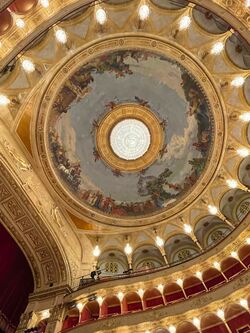From the 18th to the 19th century, a kind of theatromania took hold in bourgeois society. In 1875, only a year before the Festspielhaus Bayreuth began a fresh era, the new Paris Opera was the most spectacular realisation of Italian-style theatre.
In the Paris of the second half of the 19th century, the construction of the Opera (Q365) is linked to the transformation of the city as an important part of an urban reconstruction. In an economic situation of capital accumulation, the Prefect of the city, Baron Haussmann, organised a system of urbanisation in which public power and private interests went hand in hand. The construction of the city of liberal capitalism has well-defined framework of rules, in which the public building acts as a monument with character, embellishing urban areas.
The work of Charles Garnier (Q531), a synthesis of the École des Beaux Arts and the empiricist movement, is a blend of rationalism and picturesque style. The interior and exterior of the building are related: the play of the various volumes of the building reveals the different parts of the Opera House. Garnier articulates the masses according to a sequence which can be perceived from afar thanks to the differentiation in planes established by the play of the roofs. The volume of the stage tower acts as a pictorial background to the composition, in which the top of the gabled roof outlines a silhouette which, despite the differences, is similar to that of classical temples. The dome of the auditorium emerges in the intermediate plane. And in the foreground is the colonnade of the foyer.
Inside, the Paris Opera House displays in all their splendour the emblems which had characterised the Italian-style theatre. For a long time, the stairs had been limited to providing access to the different floors of the building. In Giuseppe Piermarini’s Teatro alla Scala in Milan (Q2610), inaugurated in 1778, the magnificence of the hall contrasts with the meagre size of the foyer. For the Paris Opera, Garnier did not use the model of the Burgtheater Vienna (Q7817) by Gottfried Semper, inaugurated in 1888, where the spectator enters the auditorium with almost no preliminary space, ascending a staircase with a certain authoritarian air that expresses well the power of the emperor and the aristocracy's desire for ostentation, but which does not make the access theatrical, playful. In Paris, Garnier multiplies the opportunities to contemplate the arrival of the spectators like a stage director. The ascent takes on a less abrupt, more fluid movement. An architectural promenade in which the foyers provide an opportunity for rest, for conversation before entering the auditorium or during intermission.
The audience boxes are described by Marcel Proust in A La Recherche du Temps Perdu as ‘small hanging rooms with one of their partitions removed’, in words almost identical to André Antoine’s definition of the theatre stage: a room with one wall removed - the fourth wall. The boxes thus serve as a stage as well as a tableau. Their occupants must be experts in the art of balancing the act of seeing and the act of showing. They must know how to appear and disappear.
However, the boxes had to fight against the amphitheatrical layout of the auditorium, preferred by the spirit of the enlightenment for both ethical and aesthetic reasons. For the enlightenment, the sad repetition of the boxes broke the unity of the hall and prevented the celebration of a collective, communal spectacle. It is for this reason, and because of its classical reference, that Richard Wagner adopted the amphitheatre as opposed to the boxes in the Festspielhaus in Bayreuth (Q7857).
In bourgeois opera houses, the boxes win the contest. Among them, the royal box, when it is there, acquires a singular presence. The royal box is an eye, that of the King set up as a superior divinity. Because of its size, the royal box makes the monarch present in the hall even when he is absent. The French arrangement places the monarch on the proscenium, the king ceases to see the scene to offer himself to the admiration of the hall.
The chandelier and the ceiling of the auditorium are further emblems of opera houses. The sun and the sky cover the auditorium and offer yet another opportunity for the artists and craftsmen whose work gives the building its splendour. And finally, completing this ensemble and marking the boundary between the world of reality and that of fiction, the curtain of the mouth unfolds, another opportunity to load the universe of the architecture of bourgeois operas with symbols and allegories.

